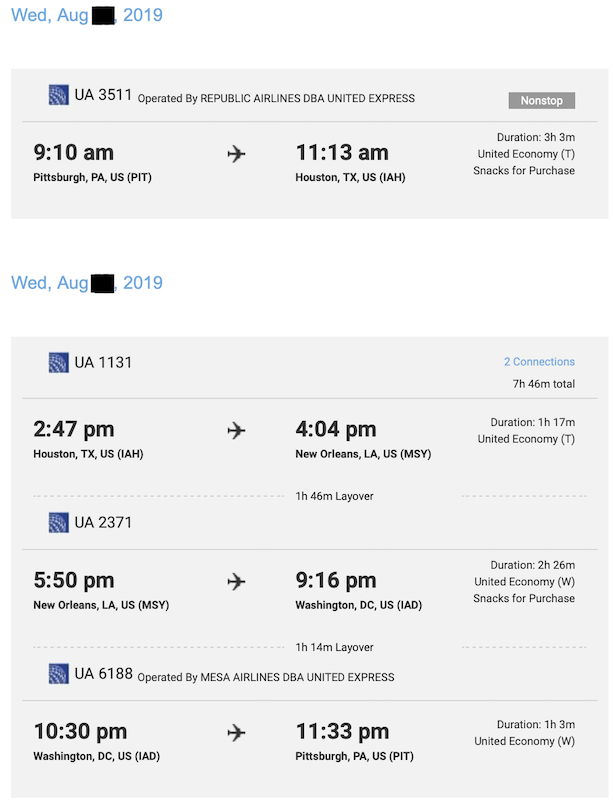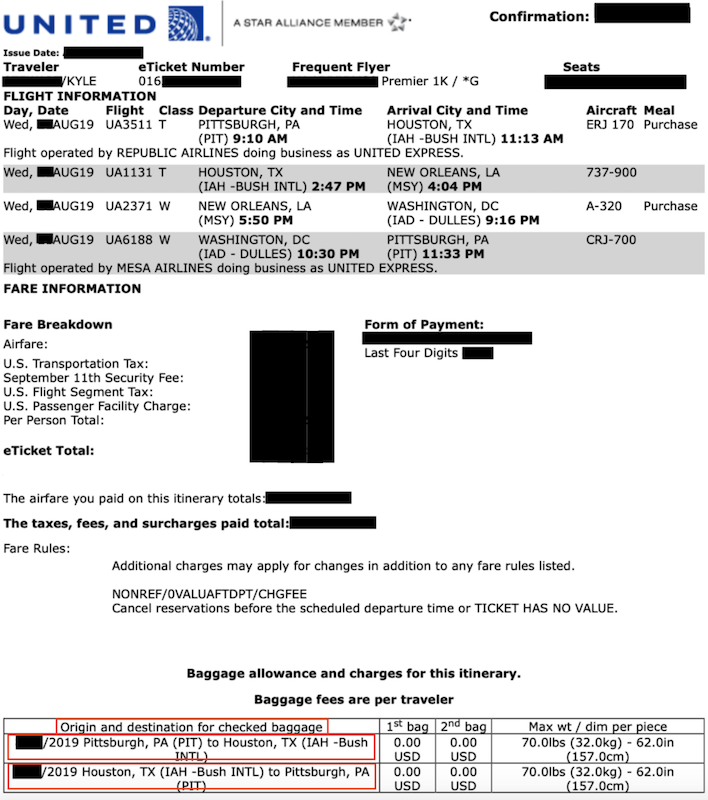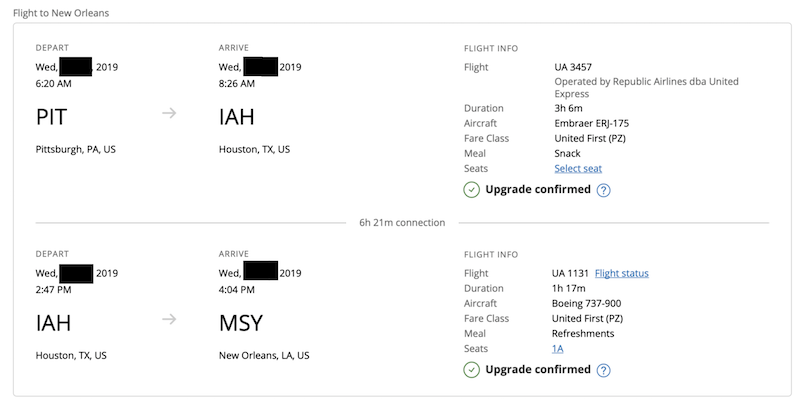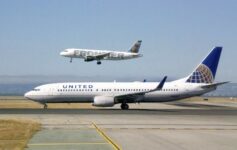On a recent day trip to Houston (yes, these exist outside of mileage and status runs) United’s website broke their own ticketing rules and forced me into a Hidden-City ticket against my will.
If you are considering booking travel or signing up for a new credit card please click here. Both support LiveAndLetsFly.com.
If you haven’t followed us on Facebook or Instagram, add us today.
Hidden-City Tickets
Hidden-City tickets are a constant source of debate by frequent and infrequent travelers alike. For those unfamiliar, airlines charge different prices based on the origin and destination, not the actual flight or distance. For example, a flight from LAX to Chicago O’Hare (ORD) direct may cost $500 in coach roundtrip, while LAX to Orlando with a connection in O’Hare is just $200 roundtrip.
The reason for the difference in price and lower cost is because customers will pay a premium to fly direct while they may book away from the airline if they have to take a connection. Pricing flights like the example above allow carriers to earn their premium on those willing to pay for direct flights, and helps them steal business from their competition when they don’t offer a non-stop flight on the route.
United Detests Hidden-City Tickets
Hidden-city tickets would be the LAX-ORD in this example. Some customers may be tempted to book this but shouldn’t do so blindly as there are lots of potential hurdles (re-routing, checked luggage, etc.) The airline hates the act of circumventing their ticketing methods so much that they threatened one repeat offender.
My Itinerary
I booked a day trip to Houston for an important meeting with a morning outbound and evening return. When I booked the trip, I knew my timeline would be tight and things often change in business but United 1K status has been great for same-day flight changes (SDFC). An SDFC allows me to switch my departure, arrival and route within 24 hours without a change fee subject to availability on the flight for free, or sometimes, a small additional payment for specific choices. United, unlike American, allows very attractive SDFC options including switching connecting cities or switching to a direct instead of the connection.
This is the ticket I booked.

As you’ll notice in the screenshot, I booked Pittsburgh to Houston on a Wednesday in August with an annoying return of Houston-New Orleans-Washington Dulles-Pittsburgh. However, it would satisfy the need and if available I could just switch to something that made more sense.
Here is a copy of my receipt which remained the same even after the departure of the first leg and a SDFC for the first flight to a more conducive time.

What United.com Decided I Wanted
Once checkin was open, I checked the app on my phone but SDFC wasn’t available as an option. I opted to call in to the 1K desk and was able to hop on a better flight for the morning, but the agent stated that for my return from “New Orleans” nothing had opened up yet. I clarified that my destination was Houston, the agent politely disagreed, we discussed and then the agent researched it further.
On their side of the system, it looked different. I pulled it up on my computer to confirm and sure enough, United.com or their backend systems had incorrectly paired the flights.


United’s website (United.com) was often referred to as “United dot bomb” for its failure to produce correct results and functionality for the better part of the late 1990s and into the 2000s. While my experience on United.com has been positive to this point, it seems like the kind of error that would justify the name.
The carrier’s website and backend software had decided that what I really wanted was not the ticket that was sold to me, my origin and destination (Pittsburgh to Houston) but rather, a flight to New Orleans with a favorable layover.
The Problem(s)
The website booked me a Hidden-City ticket to get me a better price (the direct options were about 3x as much.) Except, I didn’t want one regardless of the cost advantage.
The issues with Hidden-city tickets are numerous. If I had checked a bag, according to what I booked, I would be standing lonely at Houston baggage claim while my luggage waited in the transfer hold for my later New Orleans flight. I would have also had to claim it in New Orleans and immediately recheck it which wouldn’t have given me a ton of time. As I didn’t check luggage, I did however, have time for some New Orleans beignets.

Most importantly to me, I couldn’t change my ticket as I preferred. Had I wished to buy a restricted ticket without status, I could have saved money and bought Basic Economy on the route for a couple of hundred dollars less. The flexibility is worth it to me, so buying a ticket for more money without the same flexibility to me is like United stealing.
United’s 1K desk is usually great, hold times are rarely very long in my opinion and I have yet to encounter a problem they couldn’t overcome. Until this one. No one could help. Not the rate desk, not a supervisor, not the customer service agent who separately called me and did their level best to deliver a result for me.
If booked intentionally, a hidden-city ticket could cost you your status, miles, and even a court case. They did send me a $200 voucher for my trouble. I’m not sure that’s an even trade, but it was the most the customer service agent can do, I can’t fault them for doing 100% of what they can to correct the issue.
Conclusion
As voraciously as United has challenged Hidden-city ticket customers, it’s beyond frustrating when their own website issues Hidden-city tickets to unsuspecting customers. The consequence for me as a customer booking a hidden-city ticket could mean the forefeiture of hundreds of thousands of miles, valuable status and even a lifetime ban. With stiff penalties for what could be an honest mistake by a customer, you’d think when they commit the mortal Hidden-city ticketing sin they would be quickly and deeply repentent. No such luck.
What would you do if you were in my situation? How would you resolve the matter? Is there a more ironic United.com glitch?




I’d think about trying the Twitter team. Publicly exposing them doing what they heavily penalize customers for may get them to fix it.
I was hoping this blog post would do the same.
Please provide the linear fare quote. My guess is the T fare for PITIAH is in no way related to the IAHMSY T booking code. The 2nd or return portion is probably a broken fare in MSY based on the 2 different booking codes used for your return. UA online booking probably did not combine your O/B with the 1st leg of your return. Same booking codes does not mean a through fare PITMSY was used.
However, your itinerary is common and with SDFC, the app will see you as ONLY a local IAHMSY customer.
I specifically love that you redacted your last name on the examples, but use it in both the byline and bio.
If that is my real name…
This is definitely a weird one.
But one thing that I don’t understand — perhaps because you didn’t understand it yourself — is why United couldn’t fix this. Do you have any insight there, Kyle?
Thinking about it, I can see how this ultimately wouldn’t have made a difference to you or United. You could have flown this itinerary as laid out by the bomb with no repercussions for the airline or you IF everything went smoothly. The BIG problem would have come if you had missed your IAH-MSY flight (Houston traffic alone could have done that to you). Had that happened you would have had the rest of your return cancelled. And that’s what would have bothered me most.
I LOVE that you got yourself some beignets!
That’s the part that stumped me too – how could United not fix it? Why could they not just cancel the original return and book me as it should have been from IAH, even with an IAH-MSY-IAD-PIT return?
That’s not a hidden city ticket.
The system is reading the IAH-MSY as the connection from the PIT-IAH flight.
It’s breaking the journey in MSY as the “change of direction” or furthest point in the itinerary.
I’d dump them and go on anyone else.
I would not call this “Hidden City”, it is rather a “Broken Fare” because you booked it as a same day return. This would have never happened had you returned the day following because the connections would have been too long. It is pulling in the cheapest fares even if it means buying separate one way flights to get you to where you want to.
Hidden city implies you drop the last segment, or segments I suppose. In this case you wouldn’t have done that because you wanted to get back to PIT.
I’d really like to see the fare construction.
Ditto!
What would I do in your situation? I don’t book United. End of problem.
This isn’t “hidden city”. You are allowed to leave the airport during a layover, you aren’t locked in the building. And you are allowed to stay in the airport at your destination… maybe you were just dropping off a friend’s cat with them. Hidden city is by definition where you don’t fly the last segment(s). I’m not sure what this is, but it isn’t hidden city. It’s just a computer error.
I had some cognitive dissonance on this point, too. But what occurred to me is that, should Kyle have missed what the system called an IAH-MSY connection, as opposed to the beginning of a return trip, United would have treated this as a hidden city ticketing and canceled the MSY-IAD-PIT legs of the trip. Whereas if it had been ticketed as intended, the flat tire rule would have applied should he have arrived late at IAH. So it seems to me that one could view this as a hidden city ticketing … from a particular perspective.
The fare classes on the original receipt (insert) seems to show two fares: PIT to MSY in “T” …and MSY-PIT in “W”. Doesn’t that mean it WAS originally ticketed as a RT to MSY…not IAH?
Definitely not hidden city ticket.
I booked as PIT-IAH roundtrip and it priced 3x cheaper than other PIT-IAH itineraries. My confirmation is PIT-IAH, the system saw a cheaper fare that still worked for my requirements and booked it that way for me, but you can see I certainly pushed “buy” on a PIT-IAH and my confirmation was PIT-IAH, the back end system just couldn’t authorize it for that price so it found a way to do it that wasn’t expressly what was requested.
I see an even bigger problem. Suppose they had an issue and rerouted you from PIT to IAD and then MSY and skipper Houston completely!
Moral of the story: the house always wins
Isn’t there a violation of some kind of the contract of carriage with what happened? You very clearly bought a ticket from A to B and back again. But after your purchase United without your consent changed it to a ticket from A to C with a stop in B. They should not be able to do that.
How did you request the original availability? Was it as a round trip or did you use the multi-city option. If I attempt to request PIT – IAH RT I am only presented trips with up to two segments (i.e. one stop.) At least that is what I see today for an itinerary in the future. If I want to create (or recreate your itinerary), I would need to do a multi city request on the availability. In this case the the trip is created and priced as a RT IAH – MSY.
Requested as roundtrip PIT-IAH (which is the confirmation I received as well.)
This is interesting. What would have been bad is if your first flight to Houston were excessively delayed or cancelled and they rebooked you to New Orleans via another hub, refusing to send you to (or through, in their eyes) Houston. Your receipt clearly showed origin and destination at the bottom. There probably isn’t any intentional deception here — just likely a deficiency in the United search engine offering something that an agent would misunderstand later.
Several of the comments are asking to see the fare construction (linear). Those comments also say “broken fare” not hidden-city. You have many informed comment that are suggesting that this is not what you say it is. We want MORE info, please provide this.